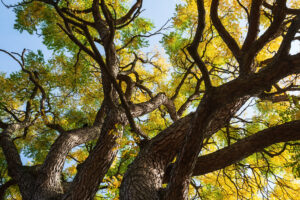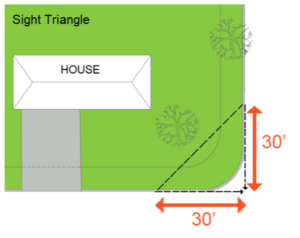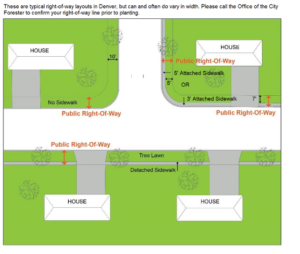You may be familiar with the program formerly referred to as “Ash GAP Removal and…
Fall Tree-Planting Tips to Help Them Thrive

Regardless of what the thermometer reads, it appears that summer is coming to an end –– which means that fall will soon bring us the gift of cooler breezes, colorful leaves, and the desire to engage in all the cozy things. It’s a beautiful season to get outside in Colorado, and the perfect time to plant a tree and contribute to our urban canopy.
Fall is a great time to plant new trees!
People tend to think of spring as the time to plant trees, but the truth is, fall can be even better! The heat of summer has left behind healthy soil, ready for planting. And there are plenty of sunny days between now and the first freeze to get those roots growing strong. There is always more to learn, but we’ve narrowed it down to some of the basics here: Everything You Need to Know About Planting a New Tree.
Where should I plant my tree?
Make sure there’s room for a new tree in your public right-of-way, especially if you’re applying for a free tree. We recommend following these spacing guidelines whether you’re applying for a free tree or planting on private property. Basic where-to-plant guidelines:
- 30 feet from the outside edge of intersecting curbs, to preserve the sight triangle
- 35 feet from large shade trees
- 25 feet from ornamental trees
- 20 feet from streetlights
- 20 feet from stop signs
- 10 feet from edge of alleys, driveways and fire hydrants
- 7 feet behind attached sidewalks
- 5 feet minimum from buried electric lines and plant ornamental trees under overhead power lines
- 5 feet minimum from water meters/pits, gas lines[MJPDCM2] , but 10’ preferred
- Centered within tree lawns/planters


How mu(l)ch is too mu(l)ch?
Applying mulch around the tree before it settles in for its winter’s nap is a very good idea. A mulch ring around your tree holds moisture in and protects against temperature extremes. It also decomposes and adds nutrients to the soil, too. We recommend learning the right way to mulch before getting started.
Fall Color 101
While the name Colorado technically means “colored red,” Denver’s variable fall weather makes it tough for that to ring true in our urban canopy. Sure, we have trees that could turn red in fall, but they don’t! The reason why? Red fall color relies on certain environmental conditions, such as a gradual change in temperature…and we all know those early snows in fall feel far from gradual. Plus, many of our favorite and recommended species tend towards yellow or brown fall colors, as these trees can handle the rapid temperature and weather changes we experience.
Tips for trees in cooler months:
Successful fall planting is a critical combination of good timing, a healthy tree and a simple care plan. Following these three tips, your trees will take root in no time.
- Good Timing – The best time to plant your fall tree is generally through October, but at minimum when nighttime temperatures are consistently above freezing. Planting a dormant tree can ensure that all the tree’s energy goes to establishing, so your tree will be well-rooted by spring.
- The Right Tree – From the Kentucky Coffee Tree to the Turkish Filbert, there are many trees that thrive in Denver’s climate, each lending its own beauty to our important urban forest. Tree diversity is the healthiest way to combat future pests and disease in our urban forest.
- Quality Care – Trees are dormant in the winter, but they still need you to keep them watered because the roots continue to grow even with what you see above ground appears to be taking its long winter’s nap. Contrary to what we’ve been told, snowmelt isn’t enough. Trees need care and watering year-round, especially in Denver’s arid climate. Just how much water is determined by the tree’s diameter. The formula is simple: 10 gallons of water for every inch of diameter of tree, with the frequency changing seasonally. (So for a 2-inch diameter tree, you need to water with 20 gallons 1-2 times a month in the winter, and more often during periods of drought (yes, we can get droughts in the winter!) Also, don’t forget to mulch, and watch for sun scald, too!
So, if you plan to plant new trees, you can use the fall season to get them going. It’s easier than you think! But if you need additional help getting going, here are some resources to find a tree care professional in Colorado.
As always, if you need more information, please contact Denver’s Office of the City Forester at forestry@denvergov.org or 720-913-0651.
